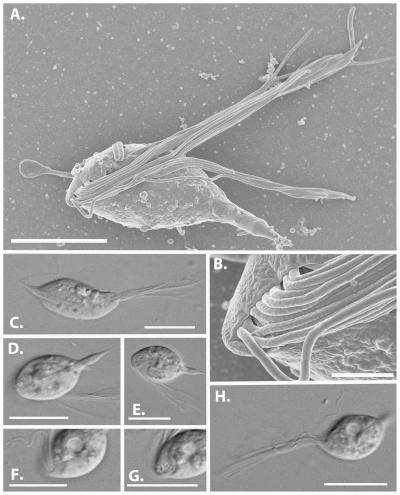Two new symbionts living in the gut of termites have been discovered. These single-cell protists, Cthulhu macrofasciculumque and Cthylla microfasciculumque, help termites digest wood. And now they have a name inspired by science fiction.
The octopus-like movements and appearance of both protists reminded lead author and University of British Columbia research Erick James of the fictional monsters created by American horror author H.P. Lovecraft Cthulhu and Cthylla. Cthulhu was depicted as a giant, octopus-like entity with wings and Cthylla is his daughter. So Cthulhu macrofasciculumque and Cthylla microfasciculumque were named after the monstrous cosmic entities in Cthulhu Mythos, as an ode to the sometimes strange and fascinating world of the microbe. And the weird world of Lovecraft too.
"When we first saw them under the microscope they had this unique motion, it looked almost like an octopus swimming," said James in their statement.

Morphology of Cthulhu macrofasciculumque by differential interference contrast light microscopy and scanning electron microscopy. Credit:University of British Columbia
Most of the larger protists living in termites have already been identified, but Cthulhu and Cthylla are very small – they are in the range of 10 to 20 microns, while the bigger protists are around 50 to 150 microns – and had passed unnoticed until now. But although tiny, the protists and their brethren have a big impact, much like their fictional namesakes.
"The huge diversity of microbial organisms is a completely untapped resource," says James. "Studying protists can tell us about the evolution of organisms. Some protists cause disease
Cthulhu macrofasciculumque showing overall body plan and the flagellar beat pattern with and without cytoplasmic undulation. Credit: doi:10.1371/journal.pone.0058509.s001
Citation: James ER, Okamoto N, Burki F, Scheffrahn RH, Keeling PJ (2013) Cthulhu Macrofasciculumque n. g., n. sp. and Cthylla Microfasciculumque n. g., n. sp., a Newly Identified Lineage of Parabasalian Termite Symbionts. PLoS ONE 8(3): e58509. doi:10.1371/journal.pone.0058509





Comments